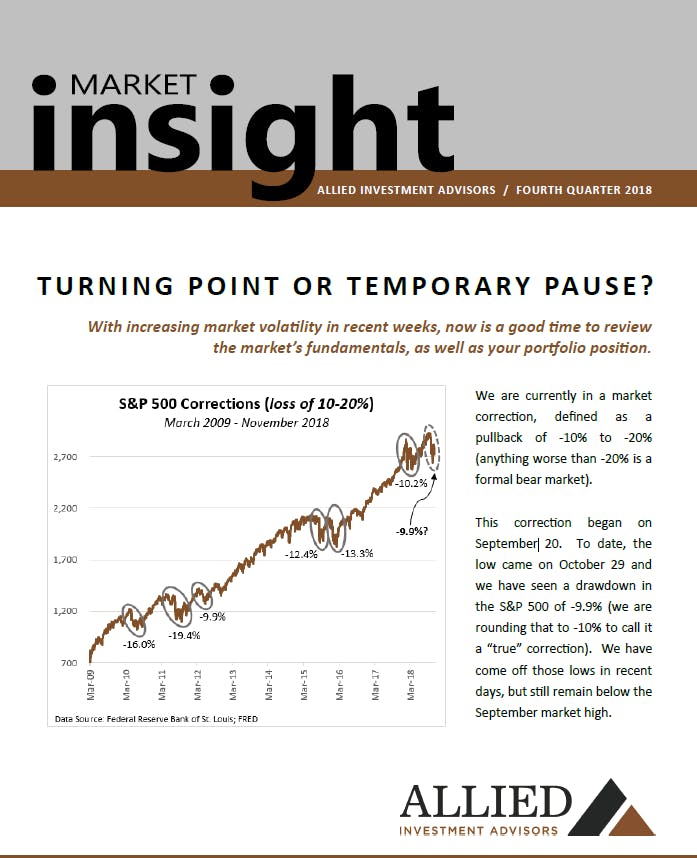Q4 2018: Turning Point or Temporary Pause?
November 16, 2018
With increasing market volatility in recent weeks, now is a good time to review the market’s fundamentals, as well as your portfolio position.
We are currently in a market correction, defined as a pullback of -10% to -20% (anything worse than -20% is a formal bear market).
This correction began on September 20. To date, the low came on October 29 and we have seen a drawdown in the S&P 500 of -9.9% (we are rounding that to -10% to call it a “true” correction). We have come off those lows in recent days, but still remain below the September market high.

The good news is that it’s not unusual to see corrections. In this bull market, which began in March 2009, we have seen one roughly every 18 months. Going all the way back to 1965, we’ve seen a 10% or greater pullback roughly once every two years. While corrections happen frequently, the market (on average) is back at new all-time highs in just four months.
While corrections are common, they are still uncomfortable. Will the current drawdown turn into a more devastating bear market, which would take more than four months to recover from? Or, will we be back at new all-time highs by year-end? Making such predictions is a tough business. Many thought the -13.3% pullback in early 2016 would lead to a recession. Instead, it led to a 22% gain for the S&P 500 in 2017.
More important than getting the short-term forecast right is to objectively weigh the fundamental evidence and make sure your portfolio is aligned with your long-term objectives.

It has been nearly 50 years since the employment market looked this strong. The chart above shows the Unemployment Rate, which at 3.7% is at its lowest level since 1969. Other indicators, like Consumer Confidence, are also hitting new highs for this economic cycle.
Some would argue that these indicators are so strong that the path of least resistance from here is down. That may be true at some point, but for now, we do not want to undermine the current strength.
The recent mid-term elections, which left us with a split Congress, are also a focal point for the economy. If you are looking for evidence of how the market reacts to a divided Congress, you can find studies that show the market does well, does poorly, or is indifferent depending on what time frame you look at or how you slice the data.
In our opinion, it comes down to the market liking clarity. If we can be comfortable that Congress will be gridlocked, that is a form of clarity the market will like. If, however, gridlock results in another 2011 style debt-ceiling crisis, which resulted in a -19.4% correction, that is not the clarity we’re looking for.

Another area to watch – and one that is also providing some opportunities – is interest rates. After being stuck near 0% since 2008, the Fed began a rate tightening campaign in late 2015. They have raised rates eight times in the past three years, with another hike expected in December. The Fed is also forecasting two more increases in 2019, which would push short-term rates to 3% by next year.
The Fed is doing its best to head off rising inflation by increasing rates. While this is a risk for the market (the Fed has a history of overshooting, and many place the blame for a number of prior bear markets squarely on their shoulders), it is also a good opportunity to review your cash holdings. While earning 2% to 3% on your cash may not sound like much, it is a lot better than the 0% you earned on a T-Bill as recently as October 2015.
We would also recommend using this opportunity to review your entire financial picture. The current economic expansion has lasted nearly 10 years and with interest rates rising and the stock market becoming more volatile in recent months, doing a portfolio review may be a good idea.
At Allied, we are happy to walk you through some cash flow modeling scenarios. We can also talk with your accountant or CPA to coordinate your entire financial picture and tax situation. Also, in specific circumstances, we may recommend an estate attorney to handle the legal aspects of estate planning and inheritance issues. No matter your situation, we would be happy to discuss your financial position in more detail.
If you have any questions about your account(s), or if there has been a change in your financial situation or investment objectives, please feel free to contact our office to schedule a meeting.

